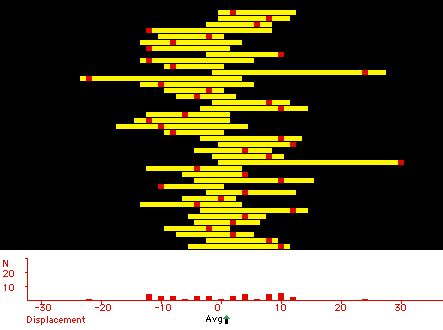
3.5 - Measuring Average Distances

SimuLabs:
8. Measures of Average Squared Displacement
Starting at the lamp post, the ant wanders a certain number of steps, randomly, to the right and to the left. The ant records its final distance from the lamp post: positive displacement measured to the right, negative displacement measured to the left. Then for the second trial the ant goes back to the lamp post and randomly takes the same number of steps again, recording its final position. Then a third trial, then a fourth trial, and so on. Finally the ant calculates the average final displacement from the lamp post from all the trials. What do you expect the average displacement to be?
We already know the answer: This average final position is zero, the starting point. This answer is verified by the numbers in the circles of Pascal's Triangle (Figure 3.7). For every row (each row representing the expected displacements after a given number of steps) the numbers in the circles are the same to the right of the initial position (positive final displacement) as they are to the left of the initial position (negative final displacement). In taking the average, final displacements to the right are typically canceled by final displacements to the left-by symmetry!
Thus zero is the average displacement of the random walker after many trials, no matter how many steps the walker takes. Yet by experimenting we know that the spread of final positions increases with the number of steps. The number of final positions available increases as the number of steps increases in Pascal's triangle. That is why the triangle is wider at the bottom. Notice that after two steps, 2 of the total of 4 possibilities leaves the ant at its starting point. That's a 50% chance. After 4 steps, 6 of the total of 16 possibilities leaves the ant at the starting point-a decrease to 37.5%.
|
There are various ways to measure this spread. We would like to get around the
fact that rightward and leftward displacements tend to cancel one another. One
possibility is to average the absolute values of the displacements.
An absolute number is never negative; therefore when we average the absolute
displacements, we will get a result that is positive (or perhaps zero). This
leads to the idea of an average absolute displacement.